Technologies
About the instruments
Jump to:
Q-Exactive HF-X
Orbitrap Fusion
Q-Exactive Plus
4000 QTRAP
H-Class UPLC
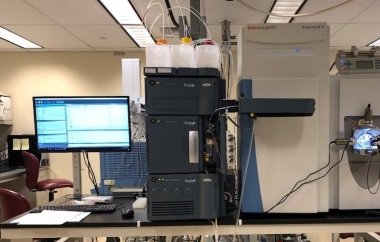
UPLC ESI Q-Exactive HF-X MS system for global proteome profiling and quantitation: A high-resolution quadrupole-orbitrap hybrid mass spectrometer from Thermo Fisher Scientific. [Back to top]
- Can reach scan speeds up to 40 Hz at a resolution of 240,000 at m/z 200.
- Equipped with a high-capacity transfer tube, electrodynamic ion funnel, and high-performance quadrupole for improved sensitivity and selection.
- Primarily designated for large-scale, bottom-up proteomic analyses such as data-dependent acquisition (DDA) and data-independent acquisition (DIA) in our facility.
- Can also be used for top-down proteomics (mass range 50-6000 m/z) as well as identification and quantitation of post-translational modifications.
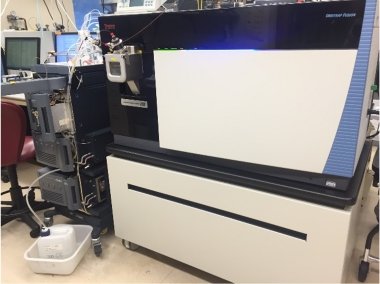
Nano-UPLC ESI Orbitrap Fusion MS systems for global and targeted proteome profiling and quantitation: A high-resolution Orbitrap Tribrid mass spectrometer from Thermo Fisher Scientific. [Back to top]
- Dual-pressure linear ion trap for CID and ETD fragmentation.
- Progressively spaced stacked-ring S-lens for efficient tight ion beam focusing.
- Active ion beam guide for improved ion transfer.
- Higher-energy collisional dissociation cell for storage and fragmentation.
- Can reach scan speeds up to ~18 Hz, obtain resolution up to 450,000 at m/z 200, provide dynamic range or >5000 within a single scan, and an upper m/z limit of 6000 in the Orbitrap.
- Primarily designated for large-scale, bottom-up proteomic analyses, such as:
- Data-dependent acquisition (DDA) and data-independent acquisition (DIA)
- Label-free quantitation (LFQ)
- Parallel-reaction monitoring (PRM)
- Labeled (tandem mass tag [TMT]) proteomics approaches
- Can also be used for top-down proteomics as well as identification and quantitation of post-translational modifications.
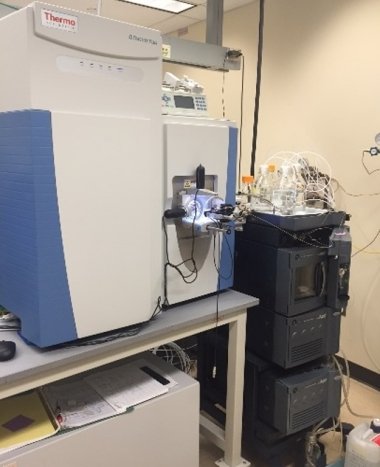
Nano-UPLC ESI Q-Exactive Plus MS systems for global proteome profiling and quantitation: A high-resolution quadrupole-orbitrap Hybrid mass spectrometer from Thermo Fisher Scientific. [Back to top]
- Can reach scan speeds up to 20 Hz at a resolution of 240,000 at m/z 400.
- High-capacity transfer tube, electrodynamic ion funnel, and high-performance quadrupole for improved sensitivity and selection.
- Primarily designated for bottom-up proteomic analyses such as data-dependent acquisition (DDA) to identify proteins and protein posttranslational modification from gel bands, immunoprecipitates, cell lysate, etc.
- Can also be used for quantitative proteomics such as SILAC and LFQ workflows.
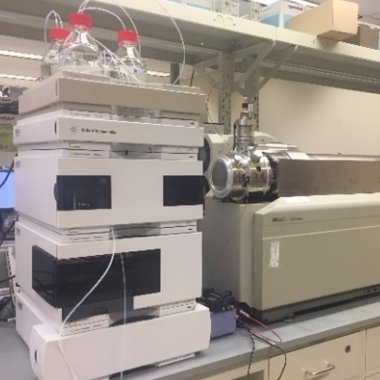
UPLC 4000 QTRAP MS system for targeted small molecule quantitation: This triple quadrupole mass spectrometer is primarily used for our small-molecule targeted quantitation workflow. [Back to top]
- Though very dependent on the analyte of interest and its ionization efficiency, this multiple reaction monitoring-based system has been utilized to detect compounds/ion with concentration range >5ng/mL.
- System is coupled to an Agilent 1200 HPLC for online separation prior to the MS detection.
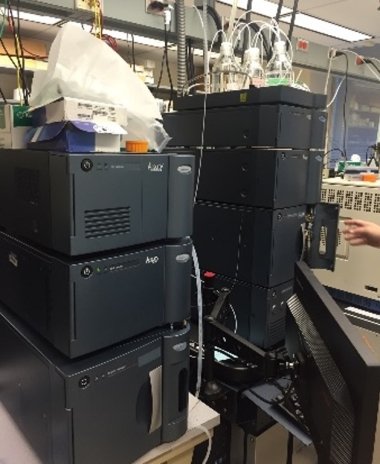
Waters H-Class UPLC for offline fractionation of proteomic and small molecule samples: An ultrahigh-pressure liquid chromatography (UPLC) system for offline peptides, proteins, and small molecule separation. [Back to top]
- Two separate temperature-controlled column compartments with capacity for two columns hooked up separately or serially.
- Plate or tube fraction collector for downstream analyses of the fractionated samples.
- Photodiode array (UV) detector connected for up to 4 UV channels recording/detection.
- Primarily used for TMT multiplex workflow, where offline high pH 1st-dimensional reverse phase separation and subsequent fraction collection is implemented to enhance proteome depth of coverage.
- Also utilized by the core/users for small-molecule separation to determine active components in a reaction mixture.
[Back to top]
Available to Yale researchers & external researchers